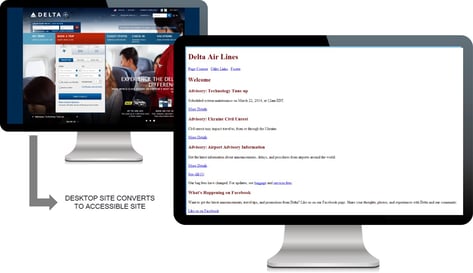Equal Access - What You Need to Know About Making Enterprise Websites Accessible

By Carin van Vuuren, Chief Marketing Officer at Usablenet
2013 was a big year for digital accessibility - the practice of removing or minimizing the barriers that prevent people with disabilities from having equal access to information and functionality.
Today, almost every business has an online presence, which means website accessibility is quickly proving to be an increasingly important issue to address. As the definition of an accessible website is becoming clearer, businesses need to take both legal factors and customer satisfaction into consideration when planning how to make systems (e.g. websites or applications) more functional for individuals with disabilities. The Necessity to Embrace Accessibility
There are a host of factors from legal, business and ethical perspectives that should motivate brands to create accessible websites.
First, companies have a legal responsibility to provide services to everyone who uses the Web, regardless of ability. In the United States, there are key legal considerations that companies need to address. Primarily, the Americans with Disabilities Act (ADA) applies to all facets of public life and prohibits discrimination on the basis of disability in employment, state and local government, public accommodations, commercial facilities and telecommunications. ADA regulations extend to the Internet. The U.S. Department of Transportation, for example, now requires airlines to make their travel sites more accessible to people with disabilities.
Web Accessibility Toolkit
To stay ahead of the curve, digitally focused businesses need greater understanding of the experiences of assistive users. Discover several techniques and technologies that progressive enterprises are using today to serve their audiences better at wsm.co/assistiveweb.
Two other legal obligations that companies need to address when creating an online presence stem from the Web Content Accessibility Guidelines 2.0 (WCAG2) and the Telecommunications Act. Published by the World Wide Web Consortium's Web Accessibility Initiative in 2008, the WCAG2 offers recommendations for companies to make their websites accessible to people with poor vision, hearing loss, limited movement and other disabilities. If a site does not meet the guidelines set forth by the WCA, then the website owner could be sued for discrimination. Finally, Sections 255 and 251A2 of the 1996 Telecommunications Act require telecommunications equipment manufacturers, educational organizations and service providers to ensure that their products and services are accessible and usable by people with disabilities.
While legal factors often require businesses to create an assistive website, companies should also be driven by a desire to deliver customer satisfaction, as the Association of Corporate Counsel reported an increase in 2013 regarding the instances of disabled individuals who complained that they couldn't access certain company websites.
How Does Assistive Work With the Original Website Code?
The most efficient way to create an assistive site is by building a dynamic text-only site. However, a big mistake that businesses make when implementing text-only sites is by simply taking a page and making it text-only, which does not imply accessibility. Text-only is also not just content related, but rather requires that all functionalities be available in "text-only" mode. Developers must also apply the guidelines set forth by ADA, WCAG2 and the Telecommunications Act to ensure that their pages are in compliance with Web accessibility standards. There are two main ways for Web developers to make sites fully accessible.
The first option is to adjust the code on the original site. While this approach does make the original site accessible, it requires a lot of work for the developer, especially with large sites that were developed with JavaScript and Ajax.
(Editor's Note: Brands can use a free service like the WAVE Web Accessibility Tool to get suggestions on how to make their pages more accessible.)
The second option is especially useful for large sites that have a wealth of content and pages. Rather than going back on every page to make each one accessible, developers generate dynamic text-only pages alongside the original ones. When a change on the original site is made, it will be reflected in the text-only version. It ensures that all of the features and functions on the assistive site are the same as on the original version.
Why Service-Based Industries Need Assistive
While the factors listed above apply to all sectors, the most important industries to implement assistive sites are federal organizations, educational institutions and those that explicitly provide services to the public. In addition, businesses that offer consumers the ability to transact on a website, also need to make sure the website is accessible to all users.
Amtrak (a publicly funded railway service), for example, makes it a priority for customers who are blind or have low vision to access online information and book reservations.
Amtrak's first step toward embracing accessibility began in Oct. 2012 when it announced the launch of a virtual online assistant, "Ask Julie." Julie answers customer questions in her own voice and quickly directs customers to the appropriate Web page or customer service contact. Travelers turn to Julie first for help booking tickets, locating baggage information, routes and train status. When Amtrak launched its assistive site in Dec. 2012 (in advance of government-mandated site regulations) one of the first things they did was extend Ask Julie to the assistive site.
Amtrak sought to eliminate obstacles faced by visually impaired users by implementing a text-only site that provides a variety of reading options for clarity (such as color scheme). The company's assistive plan also included outlining a comprehensive step-by-step browsing and booking process; building in readily available information and support lines; and offering the opportunity to tailor customizable resources for added assistance while traveling. Delta is another travel company that converted its Web pages into a friendly format for users with disabilities. The text-only pages it produces have the graphics and styling elements removed, fully accommodating individuals with visual impairments (see images).

Embrace Assistive: It's Your Responsibility
When considering website design and strategy, all businesses need to look at their current sites and ask the question: would this page create challenges for a disabled individual? If your site offers services or products that will require users to complete transactions, the answer is probably yes.
Businesses have to take responsibility for customer welfare. Although implementing an assistive site may incur costs that do not have an immediate financial benefit for the company, it reflects a positive social message that will pay off over the long-term. Businesses that devote the time and resources to create fully accessible experiences will benefit their customers, themselves and the community at large.

Subscribe to Our Newsletter!
Latest in Marketing








